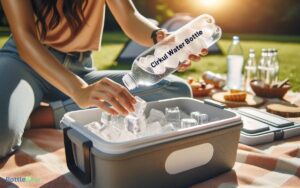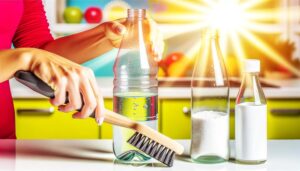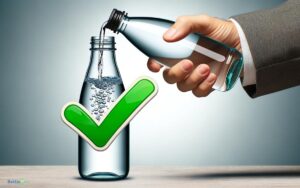Can a Dirty Water Bottle Make You Sick? Yes!
Yes, a dirty water bottle can make you sick. It can harbor bacteria like E.
coli and Staphylococcus, mold, and residual chemicals. Bacteria thrive in the bottle’s damp and enclosed environment, leading to risks of gastrointestinal issues and infections.
Mold exposure might trigger respiratory problems and allergic reactions like sneezing or skin rashes. Contaminated bottles can also cause systemic symptoms such as fatigue and headaches.
To avoid these health risks, it’s essential to clean your bottle daily using soap and warm water, and to properly dry and store it. Want to know more about staying safe and healthy with your water bottle?
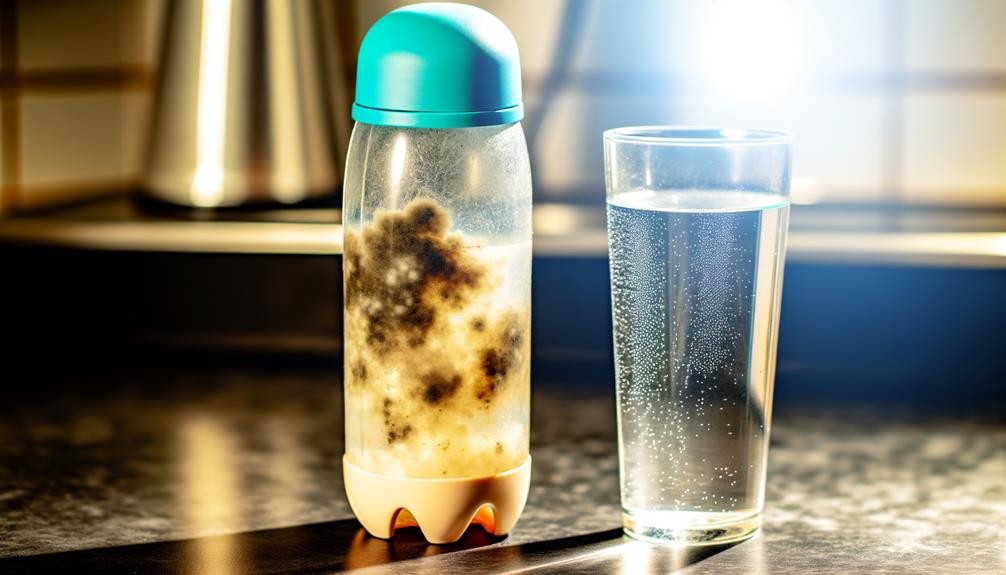
Key Takeaways
- Dirty water bottles can harbor harmful bacteria like E. coli and Staphylococcus, leading to gastrointestinal and respiratory issues.
- Mold growth in water bottles can cause respiratory problems, including asthma attacks and allergic reactions.
- Ingesting bacteria from unclean bottles can result in severe stomach cramps and infections.
- Residual chemicals from cleaning agents in dirty bottles can pose health risks.
Common Contaminants
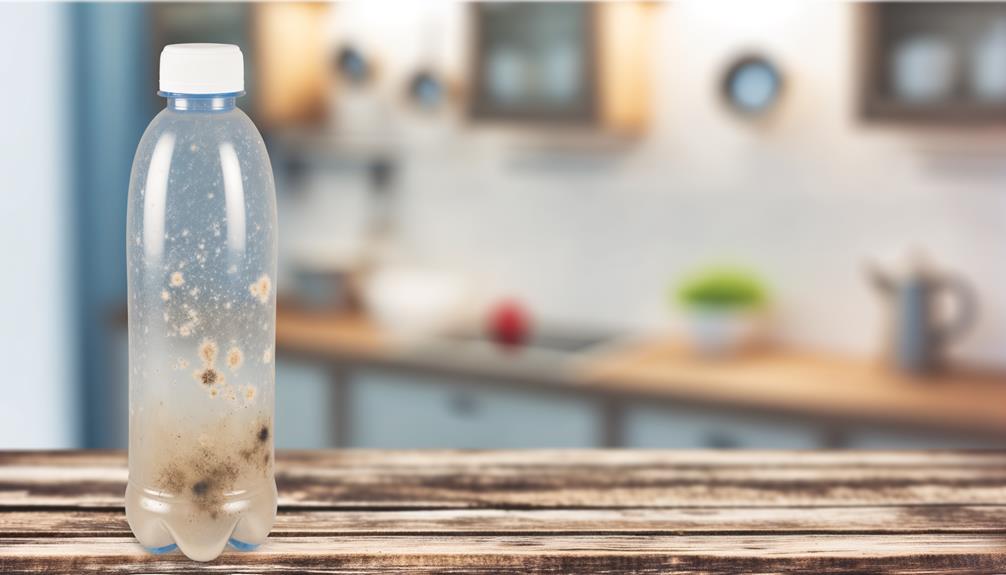
When it comes to dirty water bottles, common contaminants like bacteria, mold, and residual chemicals can pose significant health risks. You mightn’t realize it, but these contaminants can easily accumulate.
Mold, for instance, thrives in dark, damp environments, making the inside of your water bottle an ideal habitat. Residual chemicals, often from cleaning agents or the bottle’s material itself, can leach into your water over time. These chemicals can disrupt your endocrine system or cause other health issues.
Identifying and understanding these contaminants is essential. Regularly cleaning your water bottle and using materials less prone to chemical leaching can help mitigate these risks. Staying informed about what’s inside your bottle guarantees you can take proactive measures to protect your health.
Germs and Bacteria
You’ll find that bacteria thrive in the damp, enclosed environment of a water bottle, especially when it’s not cleaned regularly.
Common germs, such as E. coli and Staphylococcus, can flourish in these conditions, posing potential health risks.
Understanding the bacterial growth conditions and the types of germs that can proliferate is essential for maintaining your health.
Bacterial Growth Conditions
Several factors such as temperature, moisture, and nutrient availability create ideal conditions for bacterial growth in dirty water bottles. When you leave your water bottle unwashed, these conditions allow bacteria to thrive.
Here’s how they contribute:
- Temperature: Bacteria multiply rapidly at room temperature, especially between 40°F and 140°F.
- Moisture: Residual water provides a perfect breeding ground, as bacteria need moisture to survive and reproduce.
Understanding these factors helps you realize the importance of regular cleaning. If you don’t clean your water bottle frequently, you’re fundamentally providing a hospitable environment for bacteria growth, increasing the risk of illness.
Common Germ Types
Among the most common germs found in dirty water bottles are bacteria such as Escherichia coli (E. coli), Staphylococcus aureus, and various species of Streptococcus.
E. coli can cause severe gastrointestinal issues, including diarrhea and abdominal pain. Staphylococcus aureus, often found on the skin, can lead to infections if ingested. Streptococcus species are notorious for causing throat infections and, in severe cases, more invasive diseases.
These bacteria thrive in moist environments, making your water bottle an ideal breeding ground.
Regularly cleaning your bottle with hot, soapy water and allowing it to dry completely can help minimize bacterial growth. Understanding the risks these germs pose underscores the importance of maintaining proper hygiene for your drinking vessel.
Mold Growth
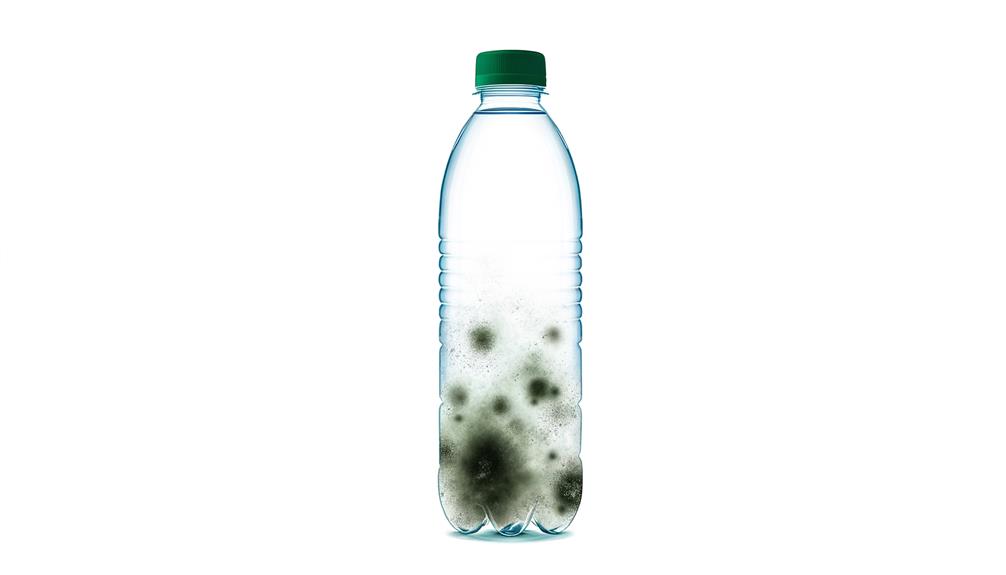
Due to the moist environment inside water bottles, mold growth can occur rapidly if the bottles aren’t cleaned regularly. Mold thrives in damp, dark areas, making your water bottle an ideal breeding ground. You might notice black, green, or white spots forming on the inner surfaces.
To prevent mold growth, consider the following:
- Regular Cleaning: Clean your bottle daily with hot, soapy water.
- Dry Completely: Verify your bottle dries thoroughly to eliminate moisture.
Health Risks
The presence of mold and other contaminants in your water bottle can pose significant health risks, including respiratory issues, gastrointestinal problems, and allergic reactions.
When you drink from a dirty bottle, you may ingest harmful bacteria like E. coli or Salmonella, leading to severe stomach cramps, diarrhea, and vomiting. Mold spores inhaled or ingested can trigger asthma attacks or other respiratory conditions, especially if you have a weakened immune system.
Additionally, allergens from mold can cause sneezing, itching, or skin rashes.
It’s essential to regularly clean your water bottle to prevent these health risks. Use a bottle brush and hot, soapy water, and make sure it’s thoroughly dried before the next use to minimize contamination.
Symptoms to Watch
When you drink from a contaminated water bottle, you might notice symptoms such as persistent stomach cramps, unexplained fatigue, or sudden respiratory discomfort. These symptoms can indicate that harmful bacteria or mold have taken residence in your bottle. In some cases, consuming tainted water over time can lead to more serious health complications, such as infections or gastrointestinal issues. While contamination is a common concern, other hazards exist as well, like accidentally swallowing a water bottle cap, which can cause choking or internal injury. To avoid these risks, it’s essential to regularly clean your bottle and ensure its components are securely in place before drinking.
Keep an eye out for:
- Gastrointestinal issues: Diarrhea, nausea, and vomiting can signal an infection.
- Respiratory problems: Sneezing, coughing, or difficulty breathing may suggest mold exposure.
If you experience any of these symptoms, it’s essential to evaluate your water bottle as a potential source.
Contaminants can quickly proliferate, leading to various health issues. Monitoring your health and recognizing these signs can help you take timely action to mitigate risks.
Cleaning Methods
To guarantee your water bottle is hygienic, you can use soap and warm water for everyday cleaning.
For a deeper clean, try a mixture of vinegar and baking soda to effectively remove stubborn residues.
If your bottle is dishwasher safe, running it through a cycle can provide a thorough sanitization.
Soap and Warm Water
Cleaning your water bottle with soap and warm water effectively eliminates harmful bacteria and residue. This method is straightforward yet highly efficient.
Start by disassembling the bottle, removing all parts like the lid, straw, and any gaskets. Use a bottle brush to scrub the interior, guaranteeing you reach all corners.
- Warm water: Enhances soap’s effectiveness in breaking down oils and grime.
- Soap: Acts as a surfactant, lifting dirt and microbes from surfaces.
Vinegar and Baking Soda
Using vinegar and baking soda offers a natural and effective method for cleaning your water bottle, guaranteeing thorough removal of odors and bacteria.
Start by filling your bottle halfway with warm water, then add a tablespoon of baking soda. Screw the cap on and shake vigorously to guarantee the baking soda mixes well.
Next, pour out the mixture and add equal parts vinegar and water. The reaction between vinegar and any remaining baking soda will fizz, helping to dislodge grime. Let it sit for about 15 minutes.
Afterward, rinse thoroughly with warm water to remove any residue. This method not only cleans but also deodorizes, leaving your bottle fresh and safe for use.
Dishwasher Safe Bottles
While natural cleaning methods are effective, having a dishwasher-safe water bottle can simplify the cleaning process even further. You can just toss it in the dishwasher, guaranteeing a thorough and consistent clean without much effort.
Here are some benefits of using dishwasher-safe bottles:
- High temperature cleaning: Dishwashers use hot water that can kill bacteria and other pathogens more effectively than manual washing.
- Ease of use: Simply place the bottle on the top rack, and the machine does the work for you.
Choosing a dishwasher-safe bottle guarantees you’re maintaining ideal hygiene with minimal effort.
Cleaning Frequency
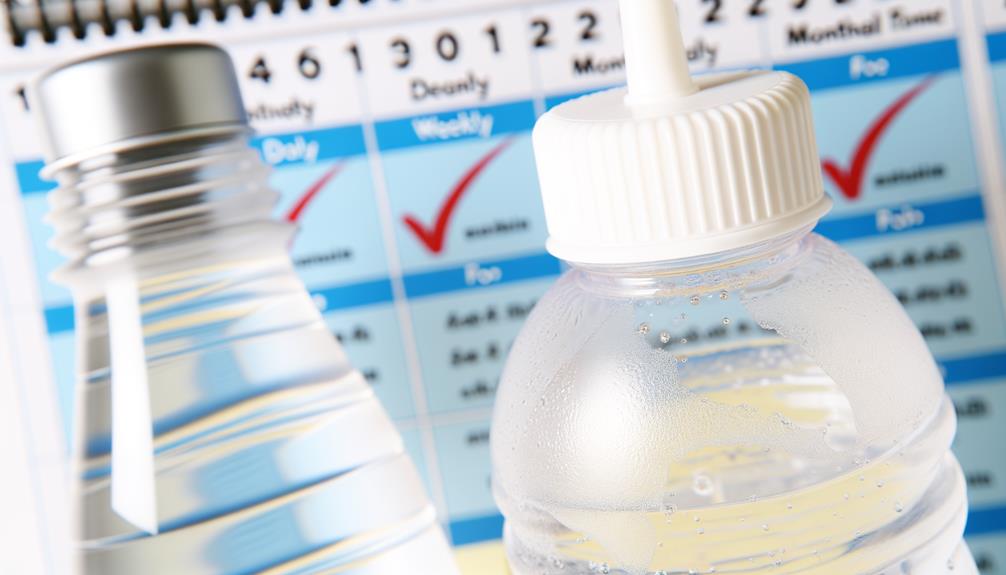
Many people underestimate how often water bottles should be cleaned to prevent harmful bacteria buildup.
Ideally, you should wash your water bottle daily. Bacteria thrive in moist environments, and even a small amount of residual water can create a breeding ground. Use hot, soapy water to clean the bottle thoroughly, paying special attention to the cap and mouthpiece, where germs often accumulate.
If you can’t clean it daily, aim for at least every other day. Regular cleaning prevents harmful pathogens like E. coli and Staphylococcus from contaminating your drink.
Don’t forget to disinfect weekly with a solution of water and white vinegar or a specialized bottle-cleaning tablet. This routine guarantees your bottle remains safe for use.
Safe Materials
Beyond regular cleaning, the material of your water bottle plays a significant role in maintaining its safety and hygiene. Different materials offer varying levels of safety and ease of cleaning.
Stainless steel, glass, and BPA-free plastic are regarded as some of the safest options. Here’s why:
- Stainless Steel: It’s durable, non-reactive, and resistant to bacteria buildup.
- Glass: It’s non-porous, meaning it won’t harbor bacteria or odors. Plus, it’s easy to clean.
Choosing the right material helps guarantee that your water stays clean and safe to drink. It’s essential to take these factors into account when selecting a water bottle for daily use.
Storage Tips
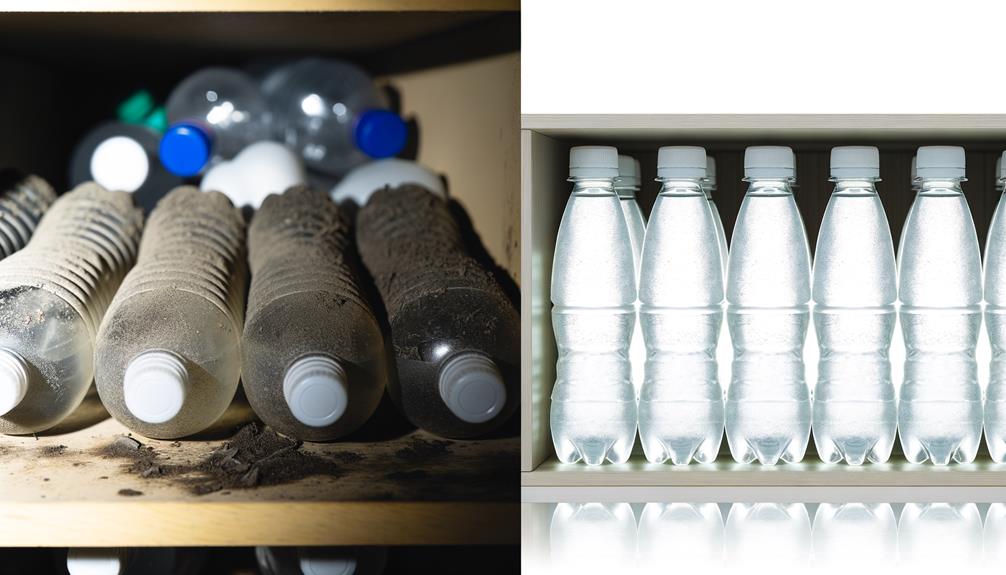
Proper storage of your water bottle is essential to maintaining its cleanliness and extending its lifespan.
After each use, empty and rinse it thoroughly with hot water to remove any residual liquid.
Dry the bottle completely before storing it to prevent bacterial growth.
Store your water bottle in a cool, dry place away from direct sunlight, which can degrade plastic and foster bacterial growth.
Avoid leaving it in damp environments like gym bags or car cup holders where moisture can accumulate.
For bottles with removable parts, disassemble and dry each component separately.
Implementing these storage practices guarantees your water bottle remains hygienic and functional, reducing the risk of contamination and keeping you healthy.
When to Replace
Knowing when to replace your water bottle is essential for maintaining ideal hygiene and ensuring your health isn’t compromised.
Over time, even the most durable water bottles can accumulate bacteria, develop cracks, or retain odors that are hard to eliminate. Pay close attention to the following signs:
- Visible Damage: Cracks, dents, or scratches can harbor bacteria and are hard to clean effectively.
- Persistent Odors: If your bottle smells even after thorough washing, it’s time for a new one.
Conclusion
So, you thought your trusty water bottle was invincible?
Ironically, it’s a playground for germs, mold, and bacteria.
Your health risks? Anything from a mild tummy ache to severe infections.
Symptoms to watch? Fatigue, nausea, and more.
Cleaning frequently and choosing safe materials can help, but don’t forget proper storage.
Still think it’s worth it?
Maybe it’s time to replace that bottle.
After all, your health shouldn’t hinge on an overlooked cleaning routine, right?


